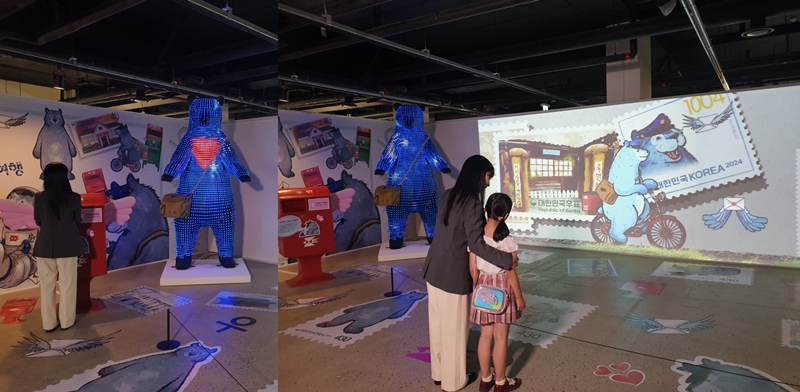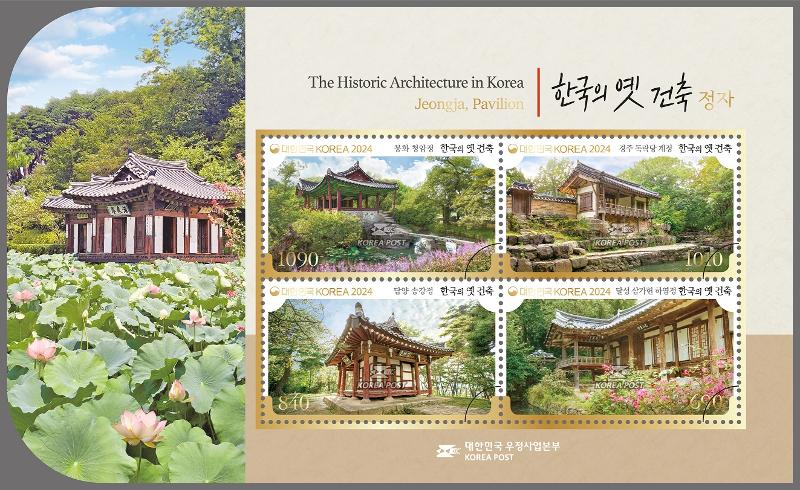
Visitors to the 2024 Korea Stamp Exhibition on its opening day of July 18 look at a work by artist Lee Jae-hyung featuring a blue bear traveling through the 140 years of domestic stamps on Nodeulseom Island in Seoul. (Koh Hyunjeong)
By Koh Hyunjeong and Margareth Theresia
Stamps contain all moments in history, covering the politics, economy, culture and history of an era, symbolized by thing of the times on the stamps including food, fashion, arts, design, trends and sports.
Rain poured on July 18 when two Korea.net staff writers visited Nodeulseom Island in Seoul's Yongsan-gu District to attend a stamp event. As soon as they entered the venue, a poster reading "2024 Korea Stamp Exhibition" greeted them.
This year marks the event's 70th anniversary and the 140th birthday of Korea Post, the domestic postal system.
Starting things was the first theme hall "Moments in History." A sign read that Korea Post began work on Nov. 18, 1884, thanks to the persistent efforts of new political reformist leaders led by Hong Young-shik, or "the father of the country's new postal system."
The history of domestic stamps probably began this way. On March 1, 1959, stamps commemorating the 40th anniversary of the March First Independence Movement of 1919 were issued.
The exhibition also featured stamps from other eras such as a series on the 1970s Saemaul Undong (New Community Movement) and economic revivals and the 1988 Seoul Summer Olympics.
The second theme hall, "Moments of Collection," featured the recognition of the social and cultural value of stamps despite the development of digital technology and spread of mobile communications greatly reducing the functionality of stamps.
Passionate stamp collectors go beyond simply pursuing their hobby and even study and research in depth related materials. To mark the 140th anniversary of Korea Post, 140 stamps by theme were shown like renowned domestic paintings, the Olympics, plants and tourist attractions.
Stamps have transcended their traditional functions and are now considered a type of content.
The third theme hall, "Moments to Come," used cutting-edge technology and media art to express the expanded value and significance of stamps and their infinite potential. Lee Jae-hyung's media art "A Blue Bear's Time Travel Through 140 Years of Stamp History" captivated the eyes and ears of children.
A person puts a letter in the mailbox to create a love mark on the bear's chest; it flies to the media wall and turns into a letter. And the blue bear mailman endlessly pedals his bicycle.
This seemed to reflect the 140th anniversary of Korea Post, which never stops.
Kim Mi-young, a first grader visiting the exhibition with her father, said in amazement, "If you put a letter in the mailbox, does a heart grow in the blue bear's chest since a letter warms the heart?"
The fourth theme hall, "At This Moment," had as its most conspicuous exhibit a "warmth mailbox pop-up." Visitors wrote their worries anonymously and put them in the mailbox, and mail carriers hand wrote responses and sent them.
Any concern like career, dreams, health, dating, depression or personality were OK. Stamps warmly connect people and convey emotions.

A commemorative stamp issued on April 24 reads "Korea's old architecture (pavilion)." (Korea Post)
Stamps are artworks that reflect a nation's culture and history. The charms of Korea's leading cultural heritage are felt through commemorative stamps.
The commemorative stamp series "Precious Cultural Heritage Revisited" issued in January showed at a glance cultural heritage recently returned to the country like the portable sundial Ilyeongwongu or Yeolseongeopil, a collection of handwritten content by kings.
Those showing royal paintings will be released on Sept. 1, UNESCO Intangible Cultural Heritage of Humanity on Sept. 27 and folk games on Nov. 14.
Pop culture stamps debuted in 2012 with those of the K-pop group Girls' Generation, the first celebrity on a commemorative stamp. Others include those featuring Korean characters in 2013, webtoons in 2017, BTS last year, and Pinkfong and Baby Shark this year.
"Because of the recent Korean culture craze, the number of foreign visitors to Korea in search of its history, tradition and pop culture is surging," Korea Post President Cho Hae-keun on July 19 said at the exhibition's opening ceremony. "We are making special efforts to make Korean stamps, which go beyond a simple means of postage, more valuable and meaningful by having them play the role of our cultural ambassador."
A virtual interactive stamp with lifelike images is displayed at the Korea Stamp Exhibition, which kicked off on July 18 at Nodeulseom Gallery in Seoul. (Korea Post)
Stamps in the digital era have fueled speculation over their future. Korea Post keeps churning out new editions using the latest technologies such as the metaverse through the exhibition while preserving their traditional look.
The evolution process has seen the introduction in 2022 of non-fungible token stamps using blockchain technology and the exhibition of characters on stamps using artificial intelligence last year. This year, the debut of the hologram realistic stamp has attracted keen attention.
"Stamps are a cultural mirror that reflects the changes of an era," President Cho said. "Stamps are a cultural tool that reflects the past, present and the future according to the changes of each era."
hjkoh@korea.kr
Most popular
- Military discharge sets stage for reunion of all 7 BTS members
- 'We are back!' BTS Festa heralds hyped return of K-pop phenom
- Presidents Lee, Trump discuss tariff deal in first phone talks
- K-pop streaming on Spotify skyrockets 470-fold in 10 years
- President Lee leaves for G7 Summit in Canada on first int'l trip
